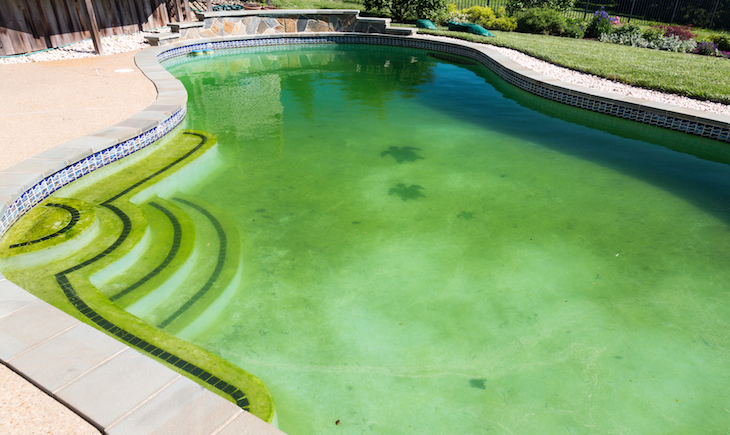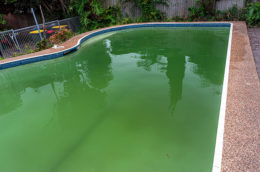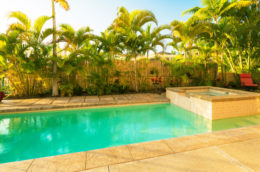
How Do I Keep My Swimming Pool From Turning Green?
So, my sister called me the other day from Ohio. She had just bought a small kiddie pool to set up on her patio. Now, before you conjure up images of a young couple with the average 2.5 toddlers scurrying about shrieking and playing, I’ll tell you, my sister and her husband are empty-nesters with a couple of grandchildren. She wanted a place to relax and cool off while taking a break from the heat of soldering her stained-glass projects together so she hit the Sprawl-Mart and got herself a swimming-pool-in-a-box. She set it up and filled it and now, four days later, the water’s turning green…what a surprise! It would have been easy to tell her to simply drain and refill the pool every few days but she fully expected me, with 40 years in the swimming pool business, to have a magic pill to solve the problem.
Understanding Water Quality
It really isn’t difficult but first we need to understand that are two facets of pool water quality: the physical condition and the biological condition.
The physical condition is largely the result of dirt and debris. This is why “real” pools have filtration systems. The system circulates the water and removes debris like sand, dirt, leaves, grass clippings, dog hair, and so on. (PS Dogs are NOT good for pools!) Filters DO NOT kill algae.
The biological condition refers to the presence or absence of biological matter such as bacteria, germs, algae, sweat, oils and other organic nasties.
The two facets are sometimes related but can usually be considered separately. I can’t tell you how many times I’ve taken a call from a pool owner that stated that his filter wasn’t working. When I asked what he meant, the answer was nearly always “I know it’s not working because my pool’s green!”
Why Not Just Chlorine?
It is entirely possible to keep pool water clear of algae without filtration by addressing the biological condition. For hundreds of years a single compound has proven to be very effective in controlling algae and that is our friend, chlorine. In a perfect world, balanced pool water with the addition of chlorine would keep everyone’s pool perfectly clear. Now, we just need to find that “perfect world!”
Where Does Algae Come From?
 Algae is everywhere. Estimates range from 35,000 to over 1 million different strains on this great planet of ours. It can be a single celled plant or a giant kale growth with 50 foot tendrils. Let’s assume that we’re not dealing with 50 foot appendages on some other-worldly man-eating plant life in our pool, although there was this one pool that I went to… well, maybe that’s a story for another day!
Algae is everywhere. Estimates range from 35,000 to over 1 million different strains on this great planet of ours. It can be a single celled plant or a giant kale growth with 50 foot tendrils. Let’s assume that we’re not dealing with 50 foot appendages on some other-worldly man-eating plant life in our pool, although there was this one pool that I went to… well, maybe that’s a story for another day!
Common algae reproduces by cell division and can emit spores into the air or it can attach itself and grow on pool screens, downspouts, roofs, trees and just about anything including the air itself. As you might imagine, a rain shower can collect the spores from the air as well as wash them off of the roof or screens and into your pristine pool. Likewise, algae can be tracked in from the yard or driveway or even brought home from the beach or lake. So much for the “Perfect World”, eh?
What Went Wrong?
So, your chlorine residual is spot on, depending on where you live this could be between 1.5 and 5 PPM (parts per million). This is generally considered enough to prevent algae but now we have a different situation. Now we have existing, live algae being imported into our pool and those levels may not be enough to kill living, reproducing algae.
Maybe, you were visiting Aunt Polly in the Catskills and forgot to boost your chlorine before you left or this was the week of your Boy Scout outing and you had 27 scouts cooling off in the pool after their camping Jamboree and a week of bathing in the lake. For whatever reason, and there could be many, your chlorine doesn’t keep up. What’s the answer?
How Do I Avoid a Green Pool?
Algicide. (or algaecide). Algicides are designed to both prevent algae from reproducing and killing algae. There are several different types. This, however, is one of those times when a “bargain” may not be a bargain. If you’ve shopped the Big Box aisle and saw a great deal on a whole gallon of algicide for under $12, run, don’t walk! Many of these are called Quaternary Ammonia based and might as well be labeled as bubble bath. They tend to foam horrendously and are only marginally effective. In an algicide, we’re looking for protection. We want something that’s going to give us another layer of prevention, to take over when our chlorine can’t keep up.
Algaecide Options
For me, eliminating the “bubble bath” leaves three accepted types of products: Sodium Bromide based products usually marketed with “yellow” in the name, like “Yellow Eradicator” or “Yellow Assasinator”. These can be effective killers but in turn exhaust the chlorine residual. I’m not a huge fan but they have their place.
Poly Quats or Poly Quaternary algicides are effective preventatives and are somewhat adept at eliminating existing algae of the more common types. (Remember, there are over 35,000 kinds!) These are generally a little more expensive but have a better track record of controlling unexpected algae blooms of the green variety. They attack through the cell walls and destroy the plant from the inside. These are usually labeled as a percentage of content as in Algicide 60 or Algicide 30.
The other type is more broad-spectrum which means it is more effective on more varieties, like a “Broad spectrum antibiotic” can treat a wider variety of infections. I’m speaking of Copper-Based algicides. I’m sure that many of you have either asked about or have been told about copper algicides and I’m also sure that some have even heard horror stories about pool staining, green hair and a host of other less than pleasant side effects.
Why Lo-Chlor Pool Algicide is Different
Lo-Chlor Pool Algicide uses copper to control algae in concert with chlorine. Copper has been fighting algae for eons. Since medieval times, copper has been used as flashing on thatched, shake and slate roofs, not because it was attractive but because as the rain water washed over the copper it would wash some of the copper ions over the roofing material and prevent algae and mold from forming by basically poisoning it.
Lo-Chlor put that science to work in their Pool Algicide. They figured out a way to keep the copper from coming out of solution while still keeping it’s algIcidic properties. The process is called “Chelation” (key-lation). It’s chemically treated with a unique organo-copper complex to isolate the copper ions and keep them contained in the water just like other minerals instead of attaching themselves to pool surfaces and your daughter’s beautiful blonde locks.
It’s has proven to be a great product for the prevention and eradication of nearly all types of algae including green, black and mustard. No, it doesn’t replace chlorine or take the place of water balance, these things should always be monitored, but it does give you the satisfaction and security of knowing that you have an added defense against the dreaded GREEN POOL! Lo-Chlor Pool Algicide is akin to your laundry booster or the spot remover in your dishwasher…not the main event but certainly a great enhancement to your pool care regimen and with a 90 day dose, the cost per year is miniscule.
So…to keep your pool from turning green, keep your water balanced and I’ll go into more detail on that in a later post, maintain your chlorine residual and don’t use a good algicide but rather a great algicide! If your local pool store doesn’t have Lo-Chlor Pool Algicide, I’m sure they can get it. Make sure that you read and follow the directions on any chemical label and here’s a tip from an old pro…use a Sharpie to mark the bottle with the date of each dose. Remember, every 3 months!
Til next time…I await your comments!
Written by Hank Graham




l cleaned the filter and added chlorine to my pool but right now it is always green, l dont know what to do
Hello Ronald,
If your pool water remains a transparent green it is probably an indication that you have a lot of copper metal in your pool water and a good metal sequestrant, like Lo-Chlor’s Metal Gone or FastStart-Tech should solve the problem. If your pool water is a cloudy, murky or opaque green you have an algae bloom. In addition to consistently maintaining effective chlorine levels, use of a powerful algaecide like Lo-Chlor’s 90-Day Algicide should rid your pool water of algae. Note that in the case of an algae bloom your filter will need to be cleaned frequently while the waste of dead algae are being cleared from your pool via the filtration system.
I do not want to swim in a pool with lots of algae formation and micro bacterial build ups. I’ve tried once because my friends convinced me to take a dip with them however, my skin got swollen, red and I was itching all over. From then on I make sure to only swim when the water is clear. Proper filtration and right balance of water must be mastered by pool owners.
So what was the resolution for your sister’s kiddie pool? Is there something we can use to keep from having to dump and refill every other day? We pay for our water and it’s running our water bill up!
Hello Lori,
For kiddie pools such as this one, which have no filter and no pump to drive water circulation, it is best to pre-treat the water before an algae bloom begins. There are two reasons for this: 1) once an algae bloom has begun, the amount of chemical required for adequate treatment will be much higher and no one wants young children bathing in a pool with higher-than-necessary concentrations of chemicals, and 2) once treatment is successful in ending an algae bloom the biological debris from the algae remains in the pool in the absence of filtration. This debris becomes fuel for the next generation of potential algae blooms and, possibly, for pathogen growth. No one wants children bathing in a rich soup of biological debris nor do we want to invite future water quality problems.
So for kiddie pools, pre-treatment to avoid the onset of algae growth is by far the preferred route to clear, safe, algae-free water for the kids. The best products for this are a chelated copper-based algaecide like our 90-Day Algicide and/or a phosphate remover like Lo-Chlor’s Lo-Phos Max. (Phosphates in the water constitute a critical nutrient for algae in pool water; without it they can’t reproduce.) Both products are widely used, in fact these are our two top-selling products. Both products are also non-toxic to humans and pets and they each work extremely well as pre-treatments to use before algae growth begins.
Very good read. Makes total sense now…
Thanks for the advice!
We are happy to help!